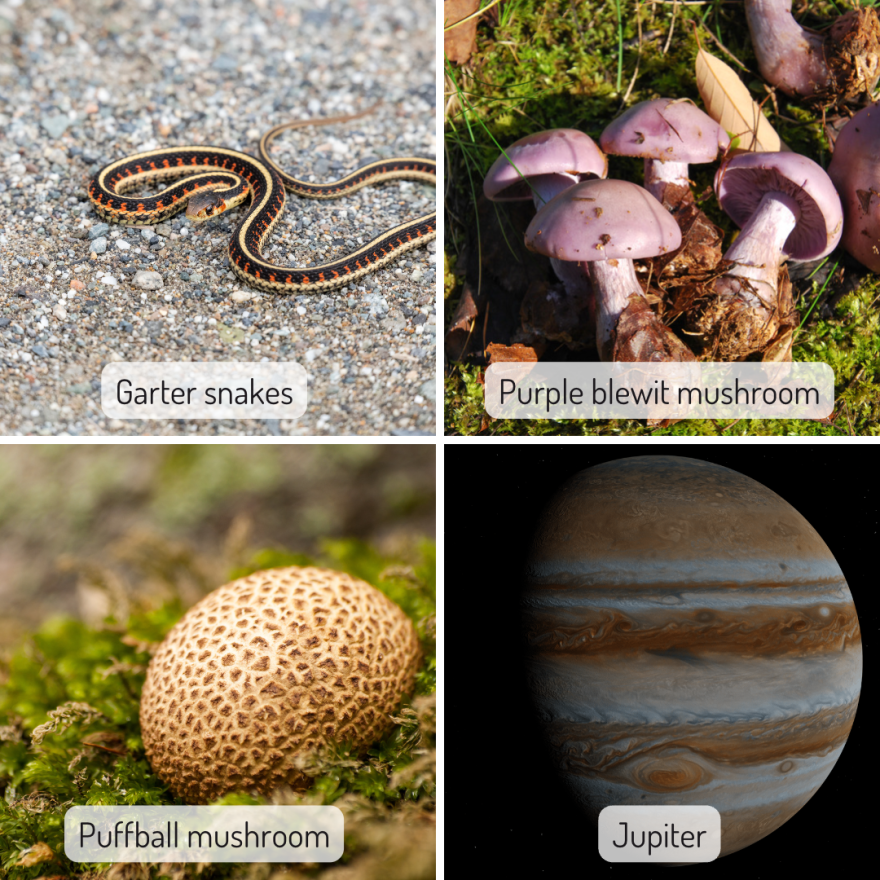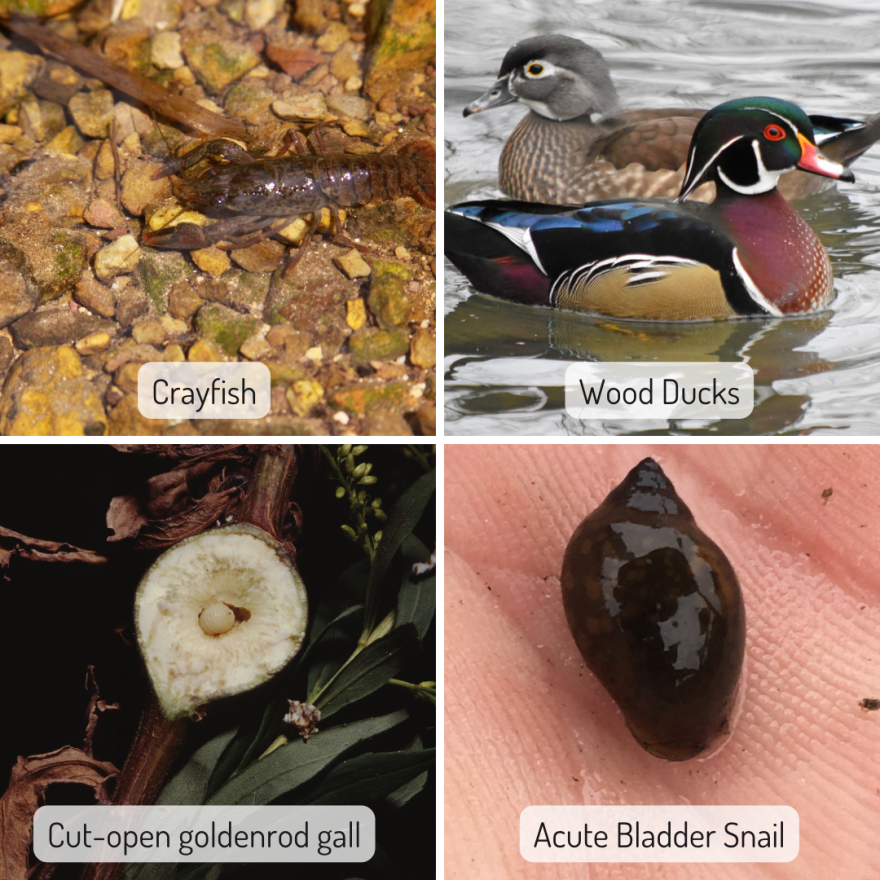The weather might be warm and sunny, but falling leaves are pelting me as I type: I can't mistake the excellent weather for summer anymore! Our students are carefully documenting the changing season, with some even recording the first snowfall of the year. Let's get into it!
Breckon is our reporter from Andrew Pierson's class at Lake of the Woods School in Baudette. Their report includes "slowly moving crayfish defending themselves from third grader's fingers," wood ducks, geese, red-bellied snakes, goldenrod galls, and acute bladder snails. On Thursday morning, they saw snow falling outside their classroom window!
John says thank you and that he also saw the snow on Thursday morning! He also points out that snakes will cross roads in higher numbers as they head to their dens for winter hibernation.
Cameron is our reporter from Tami Worner's math class at Trek North High School in Bemidji. This week, they were studying probability! Together, they designed an experiment to determine the likelihood that a falling leaf would land right-side up. However, the day they went out to perform the experiment, the leaves were stubbornly staying in the trees! They went with plan B, which was to each gather and note the positions of the first ten leaves they found. As a team, they found 110 oak leaves and 110 aspen leaves. 44% of the oak leaves were right-side up, while 61% of the aspen leaves were right-side up!
John is thrilled with their experiment and the creativity of their work "studying math in nature." He's not much on gambling, but he might be willing to reconsider if the bets were on falling leaves!

Zane is our reporter from Leigh Jackson's class at North Shore Community School near Duluth. They start with a bit of human phenology: kids wore shorts and short sleeves during the warm weather! [Like animals, humans have their summer and winter 'coats'!] However, it is getting darker earlier, and there have been several frosts. The class is carefully watching the trees and plants change color and enjoying the "leaves falling like snow" in the school forest! They've also enjoyed the ripening pumpkins and squash and eating the delicious apples. Finally, they note the arrival of slate-colored juncos and that these birds prefer sunflower seeds, cracked corn, and open-tray style feeders. They might ignore the feeder, however, and forage on the ground! "Have a great week, and be observant!"
John says thanks to Zane, reiterates a few of their observations, and agrees that it was a beautiful week to view fall colors. He points out that while Baudette and Grand Rapids saw snow on Thursday, the snow held off near Duluth until Friday. John adds that big flocks of juncos are moving through Grand Rapids and expects to see many more during this migration season!

Eme and Mike are our reporters from St. Joe's trip to Long Lake Conservation Camp near Palisade:
"During our trip to Long Lake Conservation Center from October fifth through the seventh, we had the arrival of Autumn weather. The trees are at peak color and were absolutely beautiful. Our group saw quite a few Garter snakes on the trails. Asters are still blooming, and we saw a few bees. Colorful mushrooms were a highlight of our trip. We saw Blue Stain Fungi which is carried by Bark Beetles and can be found around dead trees. It's a pretty blue color. We also saw Wood or Purple Blewit Mushrooms. They are purple and are actually edible, but don't have a very distinct flavor. Colorful mushrooms, who knew? Our favorite mushroom was the Puff Ball. We loved puffing them. During Astronomy, we saw the bands Jupiter and its four visible moons. The moon was at perigee, the closest it will be to Earth this year, and we got a good look at it. In the woods, Winterberry and Kinnikinnik or Red Bearberry Bushes are both full of berries. Kinnikinnik Berries are edible, but flavorless. The Ojibwe relied on these as a food source because they last all year. Despite the colder weather, the spring peepers and wood frogs were quite abundant and active. It's peak autumn colors… a beautiful time to explore the world. We want to remind everyone to unplug, get outside and to… LIVE CONNECTED."
John thanks the students, agrees that the winterberry is full of fruit, and adds that lots of 'herps' are getting ready to hibernate for the winter. [In this context, 'herp' is short for amphibians and reptiles: animals studied by herpetologists. The study of amphibians and reptiles is called herpetology, and many enthusiasts call themselves 'herpers.' This occasionally leads to misunderstandings.] John points out that spring peepers and wood frogs are getting ready to bed down in the leaf litter, where they will stay all winter. The garter snakes spend the winter in communal hibernacula, humid areas below the frost line where hundreds (and occasionally thousands) of snakes gather to weather the winter together. Cuddly, cozy snakes!

We have a new school this week! Hazel, Annetta, and Peter are our reporters from the Explorer's Elementary program at Roots and Wings Forest School in New York Mills. They recorded warm temperatures in the seventies, which cooled to the forties by Friday. They saw many insects, including monarchs, Asian beetles, and mosquitoes. Three classmates saw a black bear, and one student spotted a red-bellied snake! The whole class observed a woodpecker. "Thanks for listening!"
John says a big thank you for their first report! He [and I] hope to hear more from New York Mills as the year progresses. John also saw a Monarch butterfly this week and fought off a few lingering mosquitos. A few black bears are still out, but many have already disappeared to their dens.

At this point, John had to clear out for the day: I do my best to cover for him! I'm still working on my sonorous radio voice: give me a few centuries, and I might catch up to the old guy.
Artie and Vanessa from Matt Alleva's class at Hill City School. They have been busy quantifying the fall progression of autumn colors, noting 100% change in the ash tree, the red osier dogwood, the highbush cranberry, and the white/bur oak. The beaked hazel held on to a few green leaves at 90% color change. These students also reported snow on Friday, as well as heavy frost. A few notable animal encounters included a stare-down with a squirrel, a collision with a bobcat (which everyone walked away from intact), and 5 turkeys in a field! "It's a bird! It's a bee! It's phenology!"
I say a big thank you and add that the trees in West St. Paul have also almost completely changed colors. However, the leaves are still (for the most part) clinging to the branches. I enjoyed the story of the squirrel stalking the student: I see many cranky Canada geese chasing my neighbors around my block! They can get a little feisty. Finally, I'm jealous of the folks who got to see a bobcat! I've never seen one in the wild (though hitting one with my car is a sub-optimal way to encounter one, to say the least!).

Zach and Clara are our reporters from Mary Wilfahrt's Shakopee West Middle School class. They have noticed birds migrating and leaves falling from the trees, but not much change in the chilly weather.
I thank them for their report and wonder what kinds of birds they've seen migrate through! I have seen golden- and ruby-crowned kinglets, one of my top 5 "most adorable" birds. Take a peek! They're pretty friendly and will allow you to approach, but due to their small size, it can still be hard to see their markings without binoculars. Vultures, also migrating south, are easier to observe: look for them flying in a shallow 'v' shape with their wings slanting upward from their body. They rarely flap but often rock back and forth on thermals. They can be distinguished from eagles from a long distance by this flight pattern and the fact that the eagle shows a prominent head during flight: the vulture's head barely protrudes from the front edge of the wings!

Elsa and Brayden are our reporters from St. Mary's trip to Long Lake Conservation Center near Palisade:
"During our trip to Long Lake Conservation Center from October third through the fifth, we had late summer weather with all the beautiful changes of Autumn. The trees are approaching peak color, with Red Maple leaves 100 percent red with leaves falling. Tamaracks in the bog are only about 5 percent yellow and the Pitcher Plants are just starting to turn dark red. Some of our group found a few cranberries, but there are not a lot left. Our group saw lots of snakes and several blue-spotted salamanders, including a baby one. Garter and Redbelly Snakes were seen, including one that was swimming in the lake. There was an unconfirmed report of a Hognose Snake. The naturalists said that there has not been a sighting of a Hognose at Long Lake, so they are going to keep their eyes open. We saw a lot of does and fawns, but no bucks. It appears that they are starting to get their winter coats. On the lake, we observed a few Coots. Colder weather is on the way, but no matter the temperature, it's a great time to explore the world. We want to remind everyone to unplug, get outside and to…LIVE CONNECTED."
I thank Elsa and Brayden and add that I was lucky enough to attend Long Lake Conservation Center in 5th grade! Among the many things I appreciate about their naturalists, I love that they look for all sorts of life, including plants, fungi, mammals, birds, and (my favorite!) reptiles and amphibians. I'm thrilled to hear the blue-spotted salamanders are so abundant there and that there's evidence they are reproducing successfully! I'm also crossing my fingers that they'll be able to confirm the sighting of a hognose snake, one of my favorite species. Hognoses have an absolutely adorable upturned snout, which they use for burrowing and digging. They are significant predators of toads. As anyone who has caught a toad knows, toads will try to defend themselves by peeing and swelling up like a balloon. The urine drives off some predators, and the 'poofing up' tactic scares some critters away and makes other predators think, "Maybe my mouth isn't big enough to handle this!". Hognose snakes can't be driven off so easily: they aren't squeamish about the urine, and they have specialized fangs in the back of their mouth that help 'deflate' the toad to a more manageable size. (Sidenote: maybe I shouldn't tease John so much for his gruesome wildlife tangents. As our friends at Prairie Creek Community School would say, "It's not gross; it's science!")
While hognose snakes might be bad news for toads, they're pretty darn nice to us humans! They generally skip the whole "flight or fight" response and use a tactic associated with possums: playing dead. When disturbed, a hognose snake will often roll to its back, stick its tongue out, and refuse to move: if you flip it right-side up, it'll flip over again as if to say, "No really! Look how dead I am!" So, if you stop to help a snake across the road and it looks like it is already dead, take a second look: it might be a hognose snake trying to fool you.

Thank you so much to all the students and teachers who contributed reports this week: we appreciate you!
Remember that you can add your voice to this list! We would love to hear from you. Get in touch with me (smitchell@kaxe.org) or John (jlatimer@kaxe.org), or text 'phenology' to 218-326-1234.
For more phenology content, subscribe to our Season Watch newsletter!






